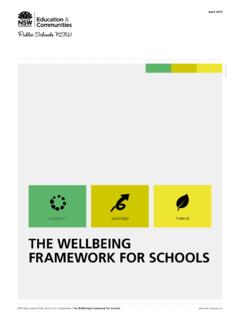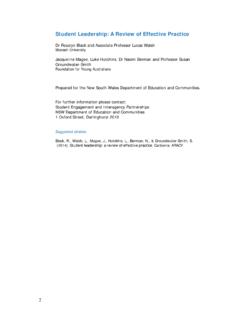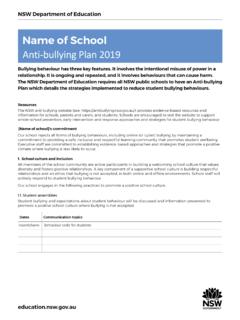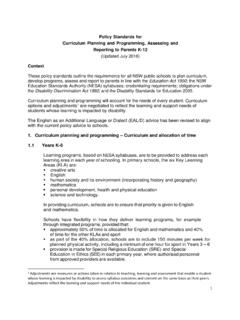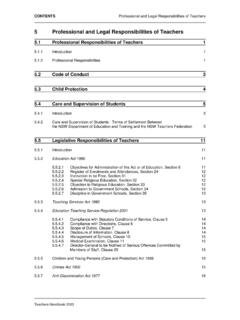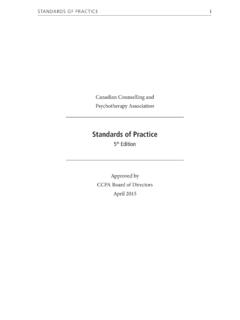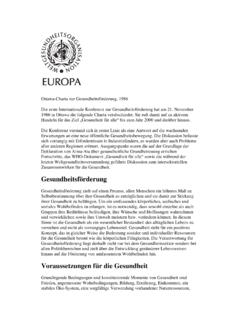Transcription of Towards Zero and the Ottawa Charter - Teacher Notes
1 Towards zero and the Ottawa Charter - Teacher Notes Stage 6 resource overview This resource is aimed at Stage 6 PDHPE HSC course students and teachers. It is to support the PowerPoint Towards zero and the Ottawa Charter . Assumed knowledge is: - Stage 6 PDHPE preliminary course (Core 1). - Stage 6 PDHPE HSC course Core 1, Focus questions 1 and 2. This resource uses the following websites and initiatives: Towards zero campaign Road Safety Plan 2021. Transport for NSW. Centre for Road Safety This resource has been developed in collaboration with Road Safety Education Officers from the NSW Department of Education Road Safety Program and teachers and students from Kellyville High School. This activity relates specifically to the Stage 6 PDHPE syllabus: HSC Core 1: Health Priorities in Australia What action areas are needed to address Australia's health priorities? All teaching and learning activities are suggestions.
2 It is the responsibility of the Teacher to deliver teaching and learning that best suits the needs of the students in their class. NSW Department of Education, Jun-20 1. Contents Resource overview ..1. The syllabus ..3. Objectives and Outcomes ..3. ACTIVITY 1. Things to consider ..4. ACTIVITY 2: Why is road safety a priority health issue? ..6. ACTIVITY 3: The trends ..7. ACTIVITY 4: The Road Safety Plan ..8. ACTIVITY 5: Looking at the ACTIVITY 6: Written response 1 ..10. ACTIVITY 7: The Road Safety Plan and the Ottawa Charter ..11. Road Safety Plan and the Ottawa ACTIVITY 8: Written response 2 ..13. Resources for ACTIVITY 3 ..13. Bibliography ..24. NSW Department of Education, Jun-20 2. The syllabus Objectives and Outcomes Objectives HSC Course Outcomes A student develops: A student: knowledge and understanding of H1 describes the nature and justifies the the factors that affect health choice of Australia's health priorities a capacity to exercise influence H4 argues the case for health promotion over personal and community based on the Ottawa Charter health outcomes an ability to apply the skills of H14 argues the benefits of health-promoting critical thinking, research and actions and choices that promote social justice analysis H15 critically analyses key issues affecting the health of Australians and proposes ways of working Towards better health for all H16 devises methods of gathering, interpreting and communicating information about health and physical activity concepts NSW Department of Education, Jun-20 3.
3 ACTIVITY 1. Things to consider . 1. What is the Ottawa Charter ? The Ottawa Charter for health promotion is the most widely used health promotion framework and was developed after the World Health Organisation held an international conference on health promotion in 1986. It is the first of its type to consider all the determinants of health and not just see health as the absence of disease. 2. List and define each of the five action areas. Build healthy public policy health promotion policy combines diverse but complementary approaches, including legislation, fiscal measures, taxation and organisation change. Health promotion policy requires the identification of obstacles to the adoption of healthy public policies in non-health sectors and the development of ways to remove them. Create supportive environments the protection of the natural and built environments, and the conservation of natural resources must be addressed in any health promotion strategy.
4 Strengthen community actions community development draws on existing human and material resources to enhance self-help and social support, and to develop flexible systems for strengthening public participation in, and direction of, health matters. This requires full and continuous access to information and learning opportunities for health, as well as funding support. Develop personal skills enabling people to learn (throughout life) to prepare themselves for all of its stages and to cope with chronic illness and injuries is essential. This has to be facilitated in school, home, work and community settings. Reorient health services the role of the health sector must move increasingly in a health promotion direction, beyond its responsibility for providing clinical and curative services. Reorienting health services also requires stronger attention to health research, as well as changes in professional education and training.
5 NSW Department of Education, Jun-20 4. 3. Define critically analyse . To add a degree or level of accuracy, depth, knowledge and understanding, logic, questioning, reflection and quality to. NESA. Revise how to answer this question using the appropriate resources for writing responses used by the class and/or school. Eg. ALARM. NSW Department of Education, Jun-20 5. ACTIVITY 2: Why is road safety a priority health issue? Suggested discussion points to review from Core 1 Health Priorities in Australia How are priority issues for Australia's health identified? Identifying priority health issues - social justice principles: each year over two-thirds of fatalities in NSW occur on country roads - priority population groups: Males are more than 2x more likely to die on our roads than females - prevalence of condition: transport crashes are the third leading cause of death from injury in Australia - potential for prevention and early intervention: behavioural factors such as speeding, fatigue and drink driving are the leading causes of fatalities on NSW roads - costs to the individual and community: costs the community over seven billion dollars per year What are the priority issues for improving Australia's health?
6 Groups experiencing health inequalities - Aboriginal and Torres Strait Islanders: the age standardised rate of injury death for Indigenous Australians was nearly twice that of non-indigenous Australians. Transport crashes were the second most frequent external cause of death for Indigenous Australians. - socioeconomically disadvantaged people: low SES are more likely to be killed in crashes than high SES. - people in rural and remote communities: over two thirds of fatalities in NSW occur on country roads High level of preventable chronic disease, injury and mental health problems - Injury is a major contributor to mortality, morbidity and permanent disability in Australia. NSW Department of Education, Jun-20 6. ACTIVITY 3: The trends . 1. Identify the initial trend you can see in this graph. Deaths on our roads have been steadily decreasing. 2. List strategies that have been implemented since the 1960's.
7 (All strategies are listed at the back of this document). 3. Classify the strategies identified in the table according to the 5 action areas of the Ottawa Charter . - Students create and complete their own table OR. - Teacher / students download The Trends - drag and drop activity to complete OR. - Use class matching activity listed at the back of this resource on pp 14-21. - Discuss observations as a class or through an online forum. - Examples to consider may include: - Which area of the Ottawa Charter had the most strategies? Why? - Could some strategies fit in more than one category? Why? - Where would the following initiatives fit best? Provide reasons for your decision. - NSW Road Safety Strategy 2012-2021. - Road Safety Plan 2021. - Future Transport Strategy 2056. These initiatives fit across all 5 action areas of the Ottawa Charter . They use a holistic approach to health promotion that combines developing personal skills, building healthy public policy, strengthening community action, creating a supportive environment and re orienting health services.
8 4. What do you notice about initiatives from 1960 -1980 compared to 1990's onwards? Initiatives from 1960-1980 focused on using rules, laws and punishment to change the behaviours of drivers. For example the introduction of demerit points and fines for not wearing seatbelts in the 1980's. From 1990 initiatives took a more holistic approach and this reflected the principles of the Ottawa Charter . Examples include the launch of the NSW Road Safety Strategy 2012 -21, The Road Safety Plan 2021 and the Future Transport 2056 Strategy. NSW Department of Education, Jun-20 7. ACTIVITY 4: The Road Safety Plan Students visit the Towards zero website to answer the questions. 1. Identify NSW's road safety targets. The NSW government have set ambitious but achievable targets to reduce road fatalities and serious injuries on NSW roads. This reflects the government's commitment to make NSW roads the safest in Australia.
9 The first target is to reduce fatalities by at least 30% from 2008-2010 levels by 2021. Every 10 years after that new road safety targets will be set to continue the move Towards zero . The ultimate aim is to have zero fatalities and serious injuries by 2056 on NSW roads. 2. Explain the road trauma challenge for NSW. Our road network gives all of us access to work, school, friends, families and the services we need. For many, it's a workplace, and for all, it's a fundamental part of everyday life that keeps the economy moving. But sadly, lives are lost, and people are seriously injured on our roads, every day. Each year, over two-thirds of fatalities in NSW happen on country roads. More than 70 per cent of the people who die on country roads are country locals. Males account for most of the fatalities and the fatality rate in country NSW is around 4 times the rate than in metropolitan NSW. The rate of serious injuries per year is not declining and the majority of these occur in metropolitan areas.
10 Behavioural factors in fatal crashes include speeding, tired drivers and riders, drink driving, seat belt non-usage, and illicit drugs being present. People who walk or ride a bicycle or motorcycle are vulnerable in a crash as the unprotected body can only tolerate so much force. Car design makes a huge difference to your safety in a crash. Of those killed in cars on our roads, around 40 percent were in cars 15 years old or older compared to around 15. percent in cars less than 5 years old. The challenge is to ensure all users of our roads, be they passengers, pedestrians, drivers, cyclists etc. are safe on our roads. The challenge is to reduce disadvantage from location, gender, socioeconomic status and behaviour. 3. Describe the Safe System approach. The safe system approach is an internationally recognised approach that considers how people, vehicles, speeds and roads work together to make a safer system.


